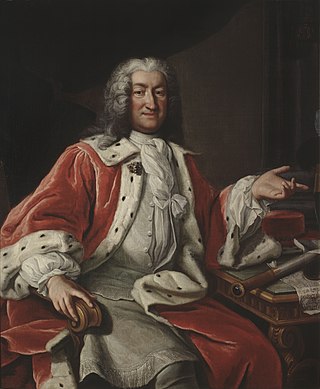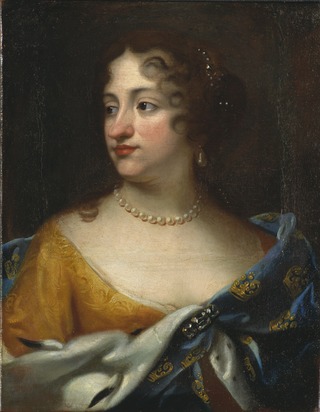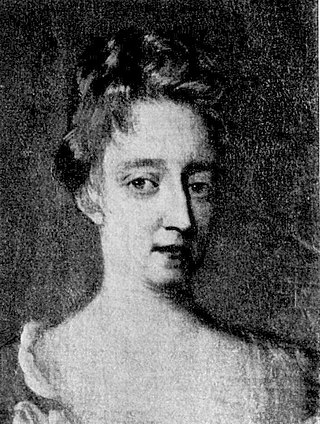Hedvig is a given name of German origin, derived from hadu ("battle, combat") and wig ("fight, duel"). Notable people with the name include:
Hedvig is a given name of German origin, derived from hadu ("battle, combat") and wig ("fight, duel"). Notable people with the name include:

Charles XIII, or Carl XIII, was King of Sweden from 1809 and King of Norway from 1814 to his death. He was the second son of King Adolf Frederick of Sweden and Louisa Ulrika of Prussia, sister of Frederick the Great.

Frederick I was King of Sweden from 1720 until his death, having been prince consort of Sweden from 1718 to 1720, and was also Landgrave of Hesse-Kassel from 1730. He ascended the throne following the death of his brother-in-law absolutist Charles XII in the Great Northern War, and the abdication of his wife, Charles's sister and successor Ulrika Eleonora, after she had to relinquish most powers to the Riksdag of the Estates and thus chose to abdicate. His powerless reign and lack of legitimate heirs of his own saw his family's elimination from the line of succession after the parliamentary government dominated by pro-revanchist Hat Party politicians ventured into a war with Russia, which ended in defeat and the Russian tsarina Elizabeth getting Adolf Frederick of Holstein-Gottorp instated following the death of the king. Whilst being the only Swedish monarch called Frederick, he was Frederick I of Hesse-Kassel and thus Frederick I also of Sweden, though other Swedish monarchs with non-repeating names had not been enumerated.

Ulrika Eleonora or Ulrica Eleanor, known as Ulrika Eleonora the Younger, reigned as Queen of Sweden from 5 December 1718 until her abdication on 29 February 1720 in favour of her husband Frederick. Following her husband's accession as King Frederick I, Ulrika Eleonora served as his queen consort until her death in 1741.

Charles XI or Carl was King of Sweden from 1660 until his death, in a period of Swedish history known as the Swedish Empire (1611–1721).

Count Arvid Bernhard Horn af Ekebyholm was a Swedish general, diplomat and politician, a member of the noble Horn family. He served twice as president of the privy council chancellery and was one of the leading figures of the Swedish Age of Liberty.

Ulrika Eleonora of Denmark was Queen of Sweden as the wife of King Charles XI. She is often admired for her generosity and charity.

Prince Charles Philip of Sweden, Duke of Södermanland, (Swedish: Carl Filip; Reval 22 April 1601 – Narva, 25 January 1622) was a Swedish prince, Duke of Södermanland, Närke and Värmland. Charles Philip was the second surviving son of King Charles IX of Sweden and his second spouse, Duchess Christina of Holstein-Gottorp.

Hedvig Sophia Augusta of Sweden, Duchess of Holstein-Gottorp, was the eldest child of Charles XI of Sweden and Ulrike Eleonore of Denmark. She was heiress presumptive to the Swedish throne from her birth until that of her brother one year later and again from the start of his reign as King of Sweden, in 1697, until her death and the regent of the duchy of Holstein-Gottorp for her minor son from 1702 to 1708. Some sources refer to her as Sofia.

Charles Frederick, Duke of Schleswig-Holstein-Gottorp was a Prince of Sweden and Duke of Schleswig-Holstein-Gottorp and an important member of European royalty. His dynasty, the Dukes of Schleswig-Holstein-Gottorp, were a cadet branch of the ancient House of Oldenburg, which at that time was ruling Denmark-Norway. His mother was a sister of Charles XII of Sweden. Charles Frederick married a daughter of Peter the Great and became the father of the future Peter III of Russia. As such, he is the progenitor of the Russian imperial house of Holstein-Gottorp-Romanov and the patrilineal ancestor of all Russian emperors starting with Peter III, except for Catherine II.

Hedwig Eleonora of Holstein-Gottorp was Queen of Sweden from 1654 until 1660 as the wife of King Charles X Gustav. She served as regent during the minority of her son, King Charles XI, from 1660 until 1672, and during the minority of her grandson, King Charles XII, in 1697. She also represented Charles XII during his absence in the Great Northern War from 1700 until the regency of her granddaughter Ulrika Eleonora in 1713. Hedwig Eleonora was described as a dominant personality, and was regarded as the de facto first lady of the royal court for 61 years, from 1654 until her death.

Frederick III of Holstein-Gottorp was a Duke of Holstein-Gottorp.
Juliana of Hesse-Eschwege was a German noblewoman. In her teens she was brought up at the Swedish royal court as the future queen of King Charles XI of Sweden, her cousin. However, on two occasions before the wedding Juliana became pregnant, and the engagement was eventually broken off. In 1679 or 1680, Juliana married a Dutchman and lived the rest of her life in the Netherlands, while Charles XI married Ulrike Eleonora of Denmark in 1680.

Hedvig "Hedda" Eleonora von Fersen was a Swedish noble and a lady in waiting to the Swedish queen, Sophia Magdalena of Denmark. She was the daughter of Axel von Fersen the Elder and Hedvig Catharina De la Gardie, and the sister of Count Axel von Fersen the Younger, Sophie Piper and Fabian von Fersen (1762–1818). In 1773, she married marshal Baron, later Count Thure Leonard von Klinkowström in his second marriage, and with him had four children, among them was the artist Hedvig Amalia Charlotta Klinckowström and Count Axel Leonhard von Klinckowström, member of the Royal Swedish Academy of War Sciences and la Société pour l'encouragement de l'industrie nationale.

Johanna Eleonora Stenbock, was a Swedish writer, poet, lady-in-waiting and noblewoman.
Hedwig or Hedvig of Sweden may refer to:

Prince Charles of Denmark and Norway was the fourth son of Christian V of Denmark and his consort Queen Charlotte Amalie, and thus a younger brother of King Frederick IV. He never married and had no children, nor did he ever engage in any political activities. Instead he maintained a withdrawn life on his estates.
Hedwig is a German feminine given name, from Old High German Hadwig, Hadewig, Haduwig. It is a Germanic name consisting of the two elements hadu "battle, combat" and wig "fight, duel". The name is on record since the 9th century, with Haduwig, a daughter of Louis the German. The name remained popular in German high nobility during the 10th and 11th centuries. Other medieval spellings include Hathuwic, Hathewiga, Hadewich, Hadewic, Hathwiga, Hadwich, Hatwig, Hadwig, Hediwig, Hedewiga, Hedewich, Hedewiih, Hatuuih, Hetvic, Haduwich, Hadawich, Hatuwig, etc. Forms such as Hadiwih, Hadewi, etc. suggest that the name is the result of a conflation of two separate names, one with the second element wig "fight", the other with the second element wih "hallowed".

Events from the year 1718 in Sweden
Eleonora of Sweden may refer to: